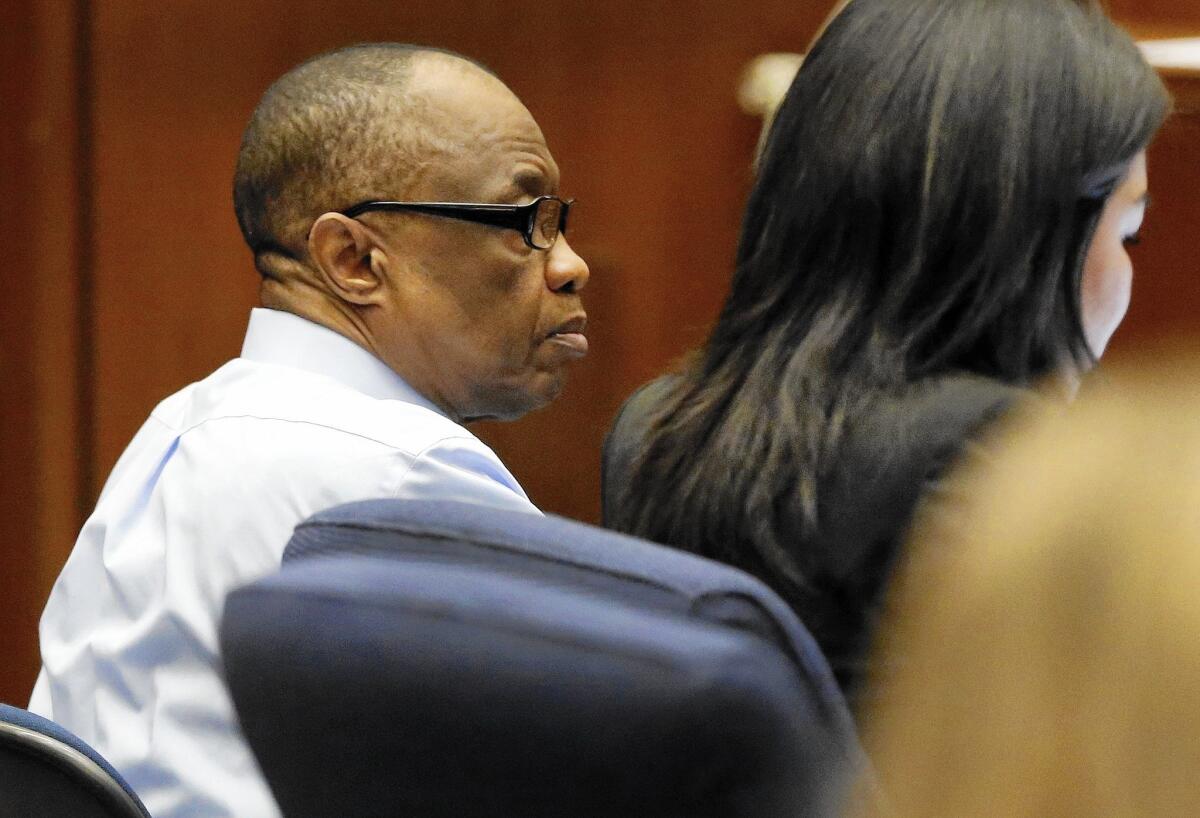Jurors in Grim Sleeper case watch detectives’ first interview with Lonnie Franklin Jr.

Lonnie Franklin Jr., with defense attorney Kristen Gozawa, in February during opening statements in his murder trial.
The detective slid the photograph across the table.
The man on the other side tilted his head, silently eyeing the picture of a smiling woman with a brown ponytail and red lipstick.
It was July 7, 2010, and on the fifth floor of LAPD headquarters, two detectives sat across from Lonnie Franklin Jr., who they suspected had killed the woman.
The woman’s name was Janecia Peters and she was killed three years earlier, Det. Paul Coulter said. Did Franklin recognize her?
“Nuh-uh,” Franklin replied.
Franklin’s DNA was found on her body, and Coulter wanted an explanation.
“You’ve never seen that girl before?” the detective asked.
“I know a lot of people, but I don’t know her,” Franklin said, shaking his head.

More than 1,000 photographs were found in the home of Lonnie Franklin Jr., the serial killer known as the Grim Sleeper. Some were released to the public to help identify the women. Thirty-five women remain unidentified.
On Tuesday, jurors in a downtown Los Angeles courtroom were shown that videotaped interview with Franklin, who had been arrested that day on suspicion of a series of slayings of women in South Los Angeles.
One after another, the detective placed photographs on the table, of Valerie McCorvey, of Princess Berthomieux, and of Alicia Alexander. He took out photos of Lachrica Jefferson, Mary Lowe and Bernita Sparks; of Barbara Ware, Henrietta Wright and finally, Debra Jackson.
Franklin was connected to all of them, the detectives said.
“I haven’t killed anybody,” Franklin answered.
Prosecutors allege that Franklin is the serial killer known as the Grim Sleeper and is linked to a series of slayings spanning more than 20 years. The women’s bodies were left in alleyways across South Los Angeles.
Franklin, 63, is charged with 10 counts of murder in the deaths of nine women and a 15-year-old girl, and one count of attempted murder. He has pleaded not guilty.
The video foreshadowed several key pieces of evidence, including DNA and ballistics, that prosecutors say connects Franklin to the women.
Former LAPD Det. Dennis Kilcoyne, who was one of the interviewers, sat on the witness stand as the video played.
“You creep out and pick up these young ladies. You have sex with them, you kill them and then you dump their bodies in alleys across the city of Los Angeles — most of them near your house,” he told Franklin.
As the three men spoke, scores of investigators were combing through Franklin’s home on 81st Street in the Manchester Square section of South L.A.
A day earlier, an undercover team had retrieved a discarded slice of pizza and other items that would be used to analyze his DNA — which matched genetic material found at some of the killing sites.
During a three-day search of his home, investigators found a .25-caliber semiautomatic handgun, which two criminalists have testified was the gun used to shoot Peters.
A criminalist previously testified that bullets retrieved from the bodies of seven women — six of whom were killed and one who survived — were fired by a different .25-caliber handgun.
Kilcoyne told Franklin, who spoke sparingly through the interview, that one of the women had survived.
“These girls can’t talk, but we have one that can.”
See more of our top stories on Facebook >>
Enietra Washington, who is believed to be the lone survivor of the Grim Sleeper killer, testified earlier in the trial that Franklin was the man who shot her in 1988.
Near the end of the video, Kilcoyne asked if Franklin had seen the billboards offering a reward for information about the slayings.
“You know what the news calls you?,” Kilcoyne said. “I know d---- well you know.”
“The Reaper?” Franklin offered.
“The Grim Sleeper,” Kilcoyne replied.
Twitter:@sjceasar
ALSO
Man convicted of killing four inside Valley Village restaurant
Defendant wants D.A.’s office kicked off O.C. case, citing witness intimidation
Have you seen this guy? Man with foul body odor sought in attempted kidnapping
More to Read
Sign up for Essential California
The most important California stories and recommendations in your inbox every morning.
You may occasionally receive promotional content from the Los Angeles Times.











